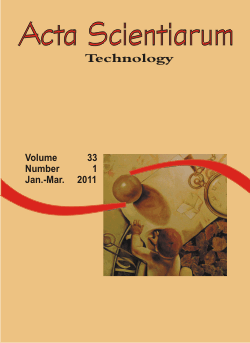<b>Kinetic of non-enzimatic browning with model solutions of sugar and aminoacids in neutral and acid pH</b> - doi: 10.4025/actascitechnol.v33i1.8360
DOI:
https://doi.org/10.4025/actascitechnol.v33i1.8360Keywords:
Maillard reaction, reaction kinetics, reaction rateAbstract
The color of food is an important attribute for consumer choice. Browning is desirable in some foods due to the color and flavor it produces (such as in bread and roasted meat), but is undesirable for others (such as heat-treated milk). The Maillard reaction is influenced by the nature of the sugars and amino acids involved, as well as the pH and temperature of the process. The aim of this work was to evaluate the browning of model solutions containing sugars and amino acids due to the Maillard reaction in neutral and acid pH, and to calculate the reaction rate and the kinetics of the reaction. Two types of sugars (glucose or lactose) were mixed with amino acids (glycine or sodium glutamate) in pH 7.0 or pH 5.1. The solutions (2 mol L-1) were heated in boiling water (97°C), and the absorbance was measured (420 nm) at time intervals. The glucose showed a higher reaction rate than lactose, whilst glycine reacted with the same intensity as glutamate. The reduction in pH of the medium delays the reaction, and browning showed a slower reaction rate in acid pH.Downloads
Download data is not yet available.
Downloads
Additional Files
Published
2011-02-04
How to Cite
Brião, V. B., Follmer, L., Souza, M. de, & Rodrigues, V. M. (2011). <b>Kinetic of non-enzimatic browning with model solutions of sugar and aminoacids in neutral and acid pH</b> - doi: 10.4025/actascitechnol.v33i1.8360. Acta Scientiarum. Technology, 33(1), 87–93. https://doi.org/10.4025/actascitechnol.v33i1.8360
Issue
Section
Food Technology
License
DECLARATION OF ORIGINALITY AND COPYRIGHTS
I Declare that current article is original and has not been submitted for publication, in part or in whole, to any other national or international journal.
The copyrights belong exclusively to the authors. Published content is licensed under Creative Commons Attribution 4.0 (CC BY 4.0) guidelines, which allows sharing (copy and distribution of the material in any medium or format) and adaptation (remix, transform, and build upon the material) for any purpose, even commercially, under the terms of attribution.
Read this link for further information on how to use CC BY 4.0 properly.











8.png)




